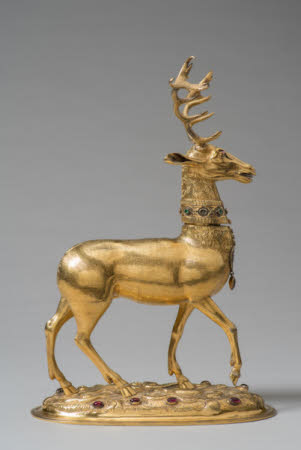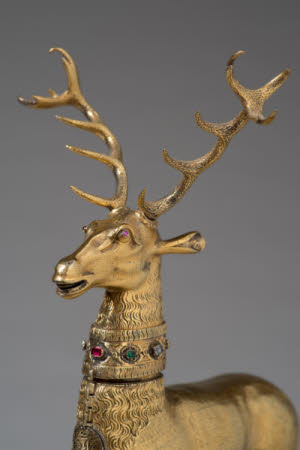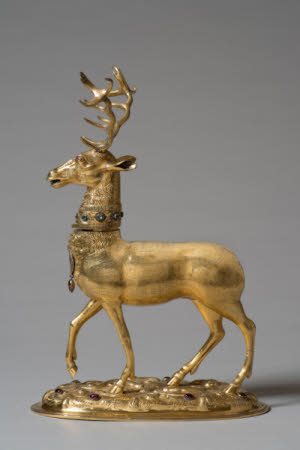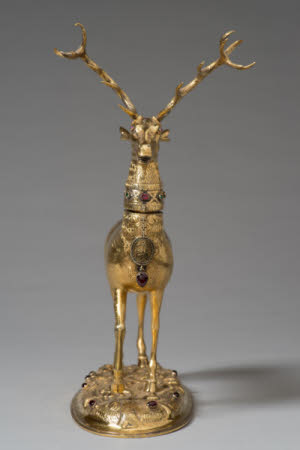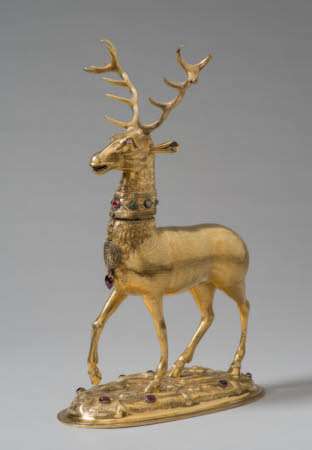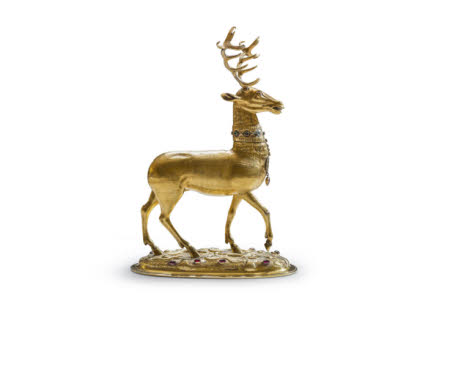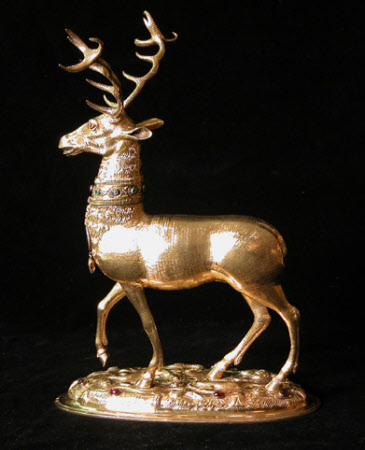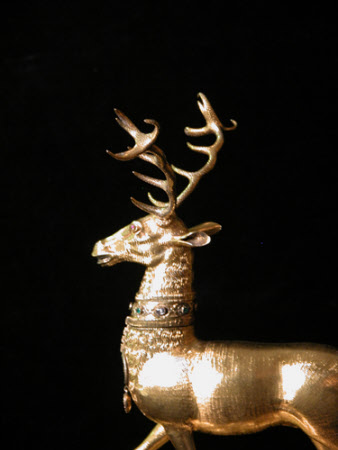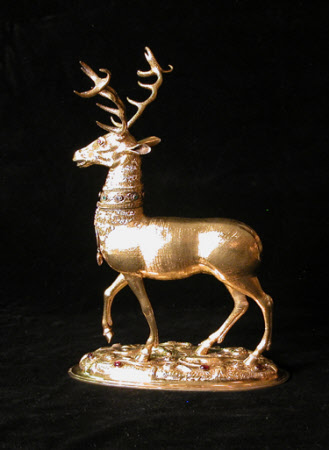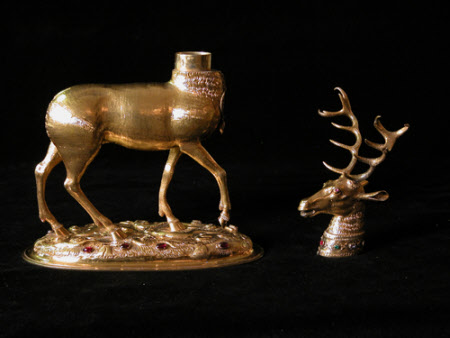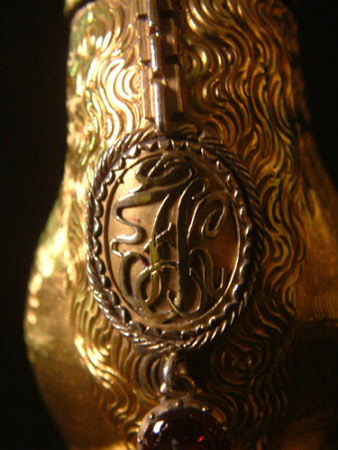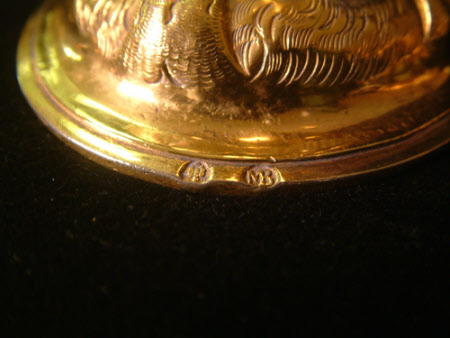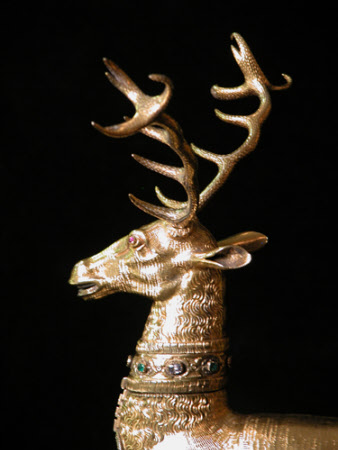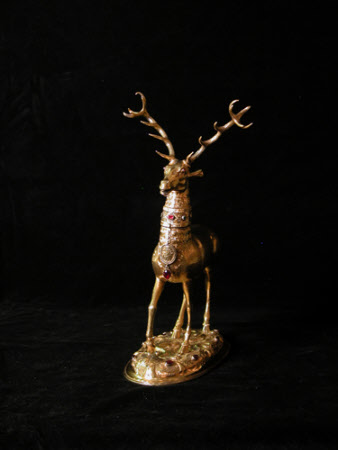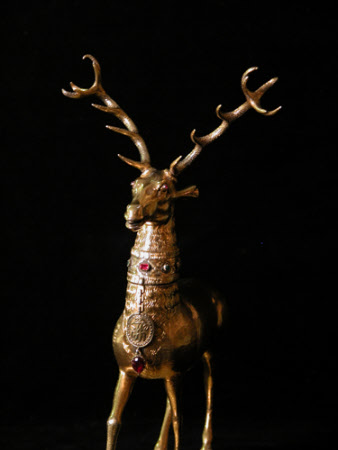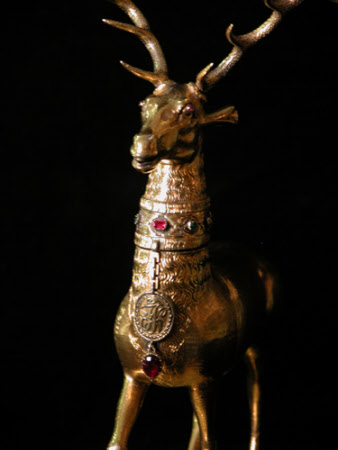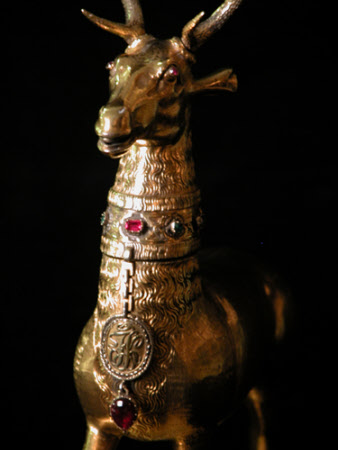A Willkomm drinking cup in the form of a stag
Melchior Baier (c.1495 -1577)
Category
Metalwork
Date
c. 1576 - 1590
Materials
Silver, gilt, rubies, emeralds, sapphires
Measurements
312 x 55 mm; 158 mm (Length)
Place of origin
Augsburg
Order this imageCollection
Anglesey Abbey, Cambridgeshire
NT 516401
Caption
This exquisite gilded stag cup would have been recognisable as a masterpiece of goldsmiths’ work both to its German maker Melchior Baier (d.1634) and to its original unknown patron or purchaser. It was made in Augsburg, the most important centre of fine goldsmith production thanks to its location, trade freedoms and religious tolerance. Baier’s studio would probably have worked closely with a sculptor to develop a design for the stag, and the work is so minutely detailed that the animal can be identified as a red deer, an animal hunted only by the nobility. Around its neck the stag wears a pendant hung with a red garnet to further enhance its rarity and beauty. The cup has a removable head and could be used for drinking wine or spirits. However, it is more likely it was used as the centrepiece of an elaborate tiered display in a banqueting room, perhaps following a hunting party.
Summary
Silver, gilt, rubies, emeralds, sapphires, A Willkomm drinking cup in the form of a stag, Melchior Bair (c. 1550-1634), Augsburg, Germany, c. 1576-1590. A silver-gilt ‘Willkomm’ (‘Welcome’) drinking cup by Melchior Bair (c. 1550-1634), made in Augsburg c. 1580-1600. The cup is in the form of a stag with magnificent antlers, which stands upon an oval base, decorated with snakes and lizards, and set with cabochon rubies. The detachable head of the stag, which has cabochon ruby eyes, forms the drinking cup. Around its neck is a collar, also set with table-cut emeralds, sapphires and rubies, from which hangs on a chain a badge with an enlaced monogram ‘F.K.’ and, suspended below this, a cabochon ruby in the form of a heart. One sapphire missing from its setting on right-hand side of the stag’s collar.
Full description
This wonderful piece of sculptural silver is an example of a type of drinking cup known as a Welcome Cup (Willkomm). In the sixteenth and seventeenth centuries, as to some extent today, communal banqueting with its rituals was a fundamental element in institutional social life, at courts, in cities and towns, and in guilds. An important element in these rituals was the Willkomm, a type of welcome cup that was especially popular in the German-speaking lands. This was an elaborate drinking vessel which would be filled with wine, and with which a guest would be greeted and, naturally, expected to down the contents. Just such a ceremony can be seen in a painting of c. 1580 depicting the Duke Ludwig von Württemberg on a hunt (Reinhold Baumstark and Helmut Seling, eds., Silber und Gold. Augsburger Goldschmiedekunst für die Höfe Europas, exh. cat., Bayerisches Nationalmuseum, Munich 1994, pp. 138-39, G1). As part of the welcome guests would often be asked also to write an entry in a special Welcome Book, a surviving example being the book for the Golden Sow of Kandern, a cup in the form of a bristling sow which also survives (Silber und Gold, pp. 140-42, Cat. 1). Welcome cups came in a very wide variety of forms but were often made in the form of game animals, reflecting the central importance of hunting to aristocratic life at the time. The most common animal forms were stags and wild boar (Silber und Gold, Cats. 1 and 2), whilst other cups could be made in the form of horses, oxen and billy goats (ibid, Cats. 5-7) and huntsmen (ibid., Cat. 17). All however had to have a detachable section, in the case of the animal cups invariably the head, which would form the actual drinking cup. Other more sophisticated drinking vessels were in the form of clockwork automata which, when wound up, would move across the table, stopping for brief periods, so that the guest before which the object halted would have to drink up the wine it contained as quickly as possible. A large number of Welcome cups in the form of stags survive (see Vincent Laloux and Philippe Cruysmans, L’oeil du hibou. Le Bestiaire des Orfèvres, Lausanne 1994, pp. 36-57; Silber und Gold, Cats. 3-4). The stag is depicted either walking or else leaping. Most have a collar, which forms the rim of the drinking cup created when the head is removed and inverted. The type of the walking stag, invariably mounted on an oval naturalistic base, was developed in Augsburg in the late sixteenth century and is probably based on bronze stags made earlier in the sixteenth century in Augsburg. As well as works by Melchior Bair, the maker of the Anglesey Abbey Willkomm, examples by other well-known makers survive, such as Elias Zorer (Schatzkammer der Residenz, Munich. Helmut Seling, Die Kunst der Augsburger Goldschmiede 1529-1868, 3 vols., Munich 1980, II, Abb. 149, III, p. 104, no. 1019a; Barbara Lehne, Süddeutsche Tafelaufsätze vom Ende des 15. bis Anfang des 17. Jahrhunderts, Munich 1985, pp. 49, and 268, Cat.1; another stag cup of c. 1605-10 by Zorer in the Ashmolean Museum (Inv. WA 2013.1.157, Bequest of Michael Wellby) and Christoph Erhart (British Museum, Waddesdon Bequest, two examples, Invs. WB.136 and 137. Hugh Tait, Catalogue of the Waddesdon Bequest in the British Museum II. The Silver Plate, London 1988, pp. 141-48, nos. 19 & 20; Dora Thornton, A Rothschild Renaissance. Treasures from the Waddesdon Bequest, London 2015, pp.22-23, fig. 10). A stag by the Augsburg goldsmith Georg Hellthaler (master c. 1567, died 1593), probably made c. 1580, is especially close in form to the Anglesey Abbey Willkomm, with a similar collar and a badge on the animal’s from suspended by a comparable chain (L’oeil du hibou, pp. 38-39). Another similar but slightly later stag by Albrecht von Horn, in the Bayerisches Nationalmuseum (Inv. 93/45. Silber und Gold, pp. 144-46, cat. 3), is datable c. 1610-20, showing that the type remained essentially unchanged over three or four decades, or indeed in some cases much longer, for example one by Heinrich Mannlich, dated to c. 1680-90 (Seling 1980, I, p. 282, II, Abb. 456). The cup is stamped on the base with the pinecone mark for Augsburg and ‘MB’, the maker’s mark for Melchior Bair. Bair, who matriculated as a master goldsmith in 1576. A turban shell cup with silver-gilt mounts by Bair, dated c. 1600-10, is in the Ashmolean Museum, Oxford (Inv. WA 1947.191.164. Timothy Schroder, British and Continental Gold and Silver in the Ashmolean Museum, 3 vols., Oxford 2009, III, pp. 1028-30, no. 439). Bair seems to have specialised in Willkomm cups, several by him being recorded, most however with horns made from coral rather than from silver. They include notably the Willkomm in the Schatzkammer des Deutschen Ordens in Vienna (Inv. G-026. Raphael Beuing, ed., Die Schatzkammer des Deutschen Ordens, Weimar 2015, pp. 142-43, no. 105). This example is known as the Zochascher Willkomm, because the pendant suspended from the stag’s collar in this case contains a later painted glass insert with the arms of a member of the Deutscher Orden, Wilhelm von Zocha, and the date 1667. The Vienna stag is dated to before 1594. It has antlers made from coral, pendant ear-rings consisting of alternating coral balls and silver-gilt pearls, and similar pendant decoration below the badge. The base is naturalistic but, instead of the embossed snakes and lizards seen on the Anglesey Abbey Willkomm, there are tiny standing enamel figures of a crane, frog, lizards and a snail. Other stags marked by Bair are recorded as in the Schloßmuseum in Gotha and in the Silberkammer in Dessau (Marc Rosenberg, Der Goldschmiede Merkzeichen, 3rd edition, 4 vols., Frankfurt 1922-28. I, p. 48, nos. 384 a and e), whilst Rosenberg also recorded an electrotype cast in the National Museum in Budapest (no. 384d). A stag cup sold by Sotheby’s Geneva (Fine European Silver, 14th November 1988, lot 35) was also attributed to Bayr by Helmut Seling. The Augsburg mark of the pinecone was regularly changed, so it is sometimes possible to date works made in the city through it. In the case of the Anglesey Abbey Willkomm, this is made more difficult however, since the lower part of the mark at the edge is missing. However, the upper part of the mark seems closest in form to marks that were in use in the period 1580-90, or possibly a little earlier (Rosenberg, I, p. 29, no. 125; Seling, III, nos. 13-15). The Anglesey Abbey Willkomm has another goldsmith’s mark, : ‘C C’ (the first ‘C’ is in fact a crescent moon) within a lozenge, twice on the inside neck of the stag and only revealed when the head is detached. This is an Austrian secondary taxation mark used for medium sized silver objects.These marks were in use from 1806 to 1824, the period of the Napoleonic wars and their aftermath, when much silver was confiscated and melted down, to help meet the ruinous expenses of the wars. They were stamped on objects to confirm that the owner of the object had paid the equivalent value of the silver in coinage, in order to avoid the loss of the object. The ‘C’ mark refers to Salzburg, so the Anglesey Abbey Willkomm must have been in a collection in that city in the early nineteenth century. The most important assemblage of silver in the city has long been the treasury collections assembled by successive Prince Bishops of SaIzburg, the surviving remains of which are mostly today in the Museo degli Argenti in the Palazzo Pitti, Florence, or in the Cathedral Museum in Salzburg (Kurt Rossacher, Der Schatz des Erzstiftes Salzburg. Ein Jahrtausend deutscher Goldschmiedekunst, Salzburg 1966). Intriguingly the first inventory of the Salzburg Silberkammer, made in 1586, records, among property specified as belonging to the recently deceased Prince Bishop, Johann Jakob Kuen von Belasy (c. 1515-1586), a stag cup: ‘Item, a gilt stag, which is a drinking vessel, weighs 3 [Salzburg Mark], 2 [Lot] and 1 [Grän]’ (Mer ain vergulten Hirschen, so ain Trinckhgeschirn ist, wigt 3 2 1’; Rossacher, p. 196). The weight of the object as recorded in 1586 was approximately 881 grams; the weight of the Anglesey Abbey stag is 825 grams, which is close enough for its plausible identification as the work recorded in 1586. Unfortunately, the cup does not appear in successive inventories of the Schatzkammer, including that for 1612 (Franz Martin, ‘Erzbischof Wolf Dietrich und die Goldschmiedekunst’, Salburger Museumsblätter, Jahrgang 8, nos. 5/6 (October-December 1929), pp. 1-7). It is possible that the stag cup was elsewhere in the Prince Bishops’ Residence. The Napoleonic wars brought about the end of Salzburg as an autonomous prince-bishopric of the Holy Roman Empire and led to the dissolution of the Silberkammer, much of which was claimed by Ferdinand III, Grand Duke of Tuscany and taken by him to Florence, the greater part today in the Palazzo Pitti. There is no mention of a stag cup in the valuation inventories drawn up in 1806, which in fact list little silver (Rossacher, p. 217). The other impediment to identification of the Anglesey Abbey stag cup with the one recorded on the death of Johann von Belasy is the badge on the neck of the stag. The monogram, in beautiful enlaced script, appears to read F.K., so does not correspond in any way to the Prince Bishop’s name. In the case of the Melchior Bair Willkomm in the Treasury of the Deutscher Orden, the enamelled plaque with arms, dated 1667, is very clearly a later addition. The FK monogram on the Anglesey Abbey Willkomm may be original rather than a later replacement, but further technical analysis would be needed to establish this. If the stag cup recorded in 1586 did survive the centuries in Salzburg, it may have left the Residenz collections before 1800 and have come into the hands of some private citizen. Nevertheless, it remains entirely feasible that it could have left the city during the upheavals of the early decades of the 1800s and so could be identifiable with the Willkomm now at Anglesey Abbey. In writing on the Christoph Erhart cup in the Waddesdon Bequest at the British Museum, which features a pacing stag, Hugh Tait commented that Melchior Bair’s Zochascher Willkomm in Vienna ‘probably represents the best Augsburg work of this type in the early seventeenth century’, an appreciation that may also be applied to Bair’s Willkomm at Anglesey Abbey. Jeremy Warren 2020
Provenance
Sir Watkin Williams-Wynn, Wynnstay; Williams-Wynn sale, 'Very fine Old English and Continental Silver', Sotheby's London, 10 October 1946, lot 120, sold for £50; David Black; acquired by Huttleston Rogers Broughton, 1st Lord Fairhaven (1896-1966) from David Black on 23 December 1946, for £220; bequeathed to the National Trust by Lord Fairhaven in 1966 with the house and the rest of the contents.
Credit line
Anglesey Abbey, the Fairhaven Collection (National Trust)
Marks and inscriptions
Front edge of base: Pinecone mark for Augsburg; ‘MB’ maker’s mark for Melchior Bair. On inside neck of stag: Austrian tax stamp ‘C C’ in lozenge twice
Makers and roles
Melchior Baier (c.1495 -1577), goldsmith
References
Seelig 1995: Lorenz Seelig, 'Silver and Gold: Courtly Splendour from Augsburg', 1995., pp. 9–15 Tait 1988: Hugh Tait, 'Catalogue of the Waddesdon Bequest in the British Museum, vol. II "The Silver Plate"', 1988., pp. 141-4 Hall, 1994: Michael Hall. “Anglesey Abbey, Cambridgeshire.” Country Life 09 June 1994: pp.102–7, p. 105, fig. 10.
